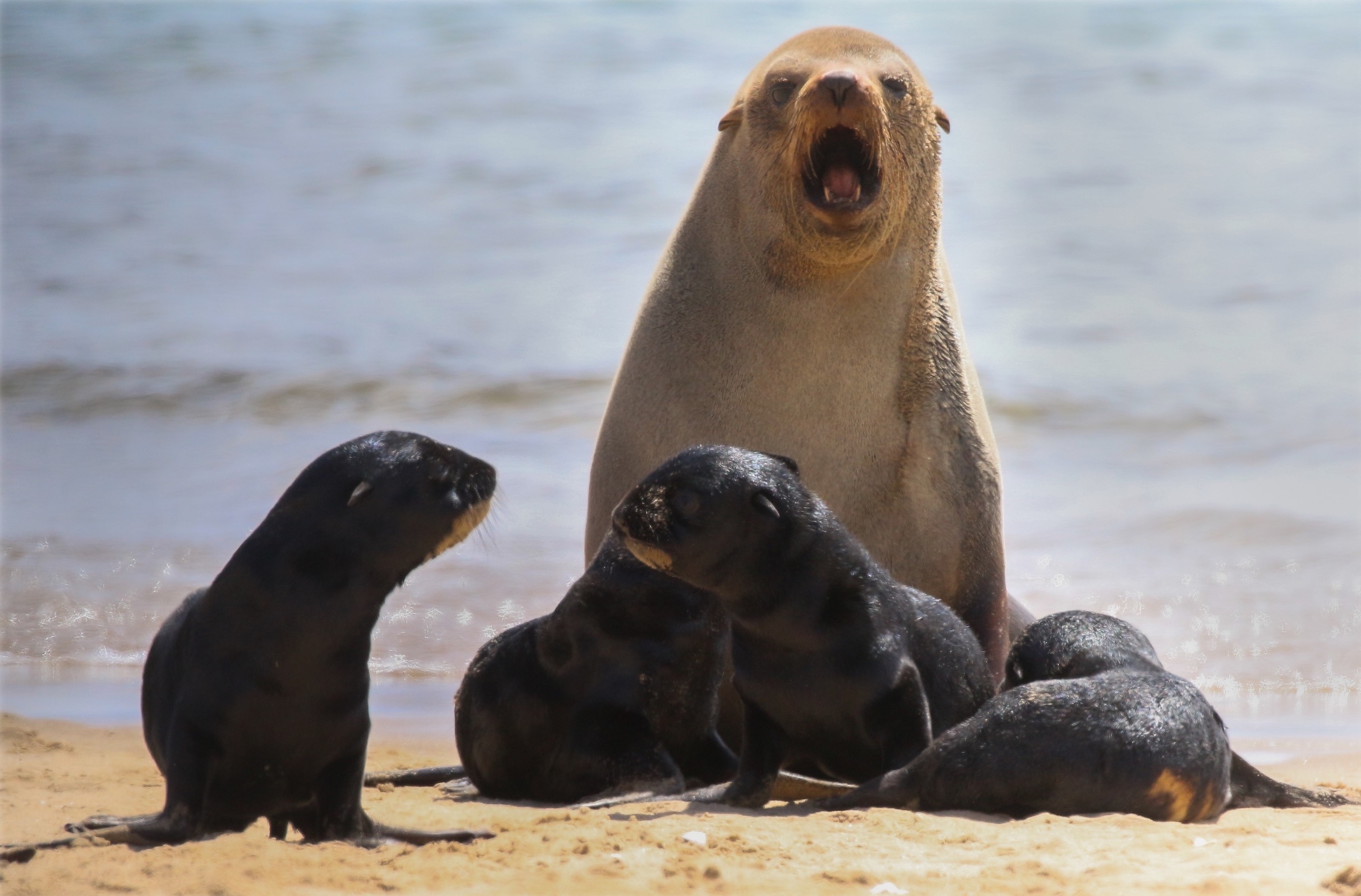The sandy shores at Pelican Point, Namibia, would be beautiful if you could see them. But during the wintry breeding season, the sand is blanketed by the brown, muscular bodies of Cape fur seals, which waddle, roll, and bask as they please in a colony that can reach up to 90,000 seals. They form a strip around the tip of the peninsula more than a mile long: "fur seals as far as the eye can see," Mathilde Martin, a bioacoustician at the University of Zurich in Switzerland, wrote in an email. To see the seals for the first time, Martin had to cross the sand for nearly 45 minutes in a four-wheel-drive vehicle. When she got out of the car, the sound of the seals walloped her. "These thousands of animals are calling almost continuously and simultaneously," Martin said. "A real cacophony!"
Martin had come to Pelican Point to listen to the seals—specifically, to listen to the calls exchanged between new mothers and their pups. Cape fur seal mothers can recognize their baby's voice amid the thunderous din of the colony within the first four hours after birth, and pups can recognize their mother's calls soon after that. This recognition ability becomes crucial as the mother seal heads out to forage in the sea as early as six days after birth, returning days later to nurse. This sonic relationship is as sweet as it is surprising, given that tens of thousands of other seals are barking around them.
By listening to mother-and-pup pairs, Martin and her colleagues honed in on what specific vocal features the seals relied on to recognize each other's calls. The researchers found the seals listen for an intricate combination of vocal features, including a call's tone, or timbre; modulations in amplitude and frequency; and its fundamental frequency. Martin conducted this research while a graduate student at the Institute of Neurosciences Paris-Saclay, CNRS & Paris-Saclay University in France, and recently published the results in the Journal of Experimental Biology.
The Cape fur seal breeding season lasts from mid-November to early January, in which time females give birth to a single pup, which they will nurse for nearly a year. Cape fur seal mothers do not provide care for other mother's pups—and are even aggressive toward them—so nursing pup needs to be able to recognize its own mother to avoid starvation or danger. And while the peninsula may look chaotic, the mammals organize themselves in various harems, each comprising a territorial male older than 9 years old, between five to 30 females, and their newborn pups, Martin said.
Cape fur seals are naturally loud. "Pups start to call a few seconds after their birth," Martin said. When adults compete for territory, a practice that involves a lot of conflict and aggression, they get very loud. Individual seals have distinct voices—the result of their body's natural variation, including the shape length of their vocal tract, hormone levels, and body size— just like us. But to compete with the cacophony, mothers and pups need to call to each other with particular, repeatable braying calls that have a clear harmonic structure and last around a second. Although many animals recognize each other by their calls, species living in dense colonies often develop even more complex vocal signatures. The researchers suspected the calls of the Cape fur seals, one of the most highly colonial mammals in the world, would have a more complex vocal signature—varying in pitch, tone, and volume—than that of other previously recorded seals, such as the Antarctic fur seal and the Australian sea lion.

To record the seals' calls, the researchers needed to infiltrate the colony of tens of thousands of seals, which is no easy feat. They relied on an age-old method of entering colonies of shy seals: crawling through the sand for about seven to eight hours each day. "The first few hours of crawling were challenging as we had to familiarise ourselves with the reaction of the seals and learn to move close to them, minimizing their reaction and vigilance towards us," Martin said. The seals were not aggressive, but some were curious about the researchers and wanted to sniff them. In such cases, the researchers would extend a long pole for the seals to sniff, to avoid getting too close. But even a successful infiltration carried risks. If the researchers spent several hours in one spot and the aggressive male seals forgot about the interlopers, the fieldwork could become treacherous. "The males can run in our direction when they are fighting over territory," Martin said. "We risked being trampled several times, so we had to be very vigilant."
Triumphantly untrampled, the researchers managed to record the calls of mother-pup pairs, and marked the pups with blonde hair dye—a minimally invasive way to keep track of their subjects. They tweaked these calls electronically, such as making them higher pitched by increasing the frequency, flattening the volume, tuning the call to encompass only one note, and randomly switching tones. The researchers played back these calls to pups when their mother had absconded for the ocean, or for mothers in the presence of their pups, and filmed the seals' reactions to see if they recognized the calls.
The researchers found the mother seals still recognized their pups' calls when they were higher pitched. But the pups' calls became unrecognizable if they were too highly pitched or monotonous, removing the sing-song quality that the mothers sought out. And pups had difficulty recognizing the altered versions of their mothers' calls, especially if they were high-pitched or had random tones. So the researchers found the seals' rely not just on their mother or pup's natural vocal register, but also a distinctly pitched, sing-song vocalization. "We were surprised by the number of parameters involved, especially in the decoding of the mother's voice by the pups, and by the associated cognitive capacities for perception and information processing," Martin said.
The distinct features of these calls become harder to discern if the seals are too far from each other, starting at about 26 feet apart. But the researchers found that mothers and pups still managed to find each other across distances of nearly 200 feet, indicating the seals may be able to pick up on these calls amid the ambient noise of the colony—an ability known as the cocktail party effect. But the seals almost certainly rely on other cues for their reunions, and Martin suggested a future study might investigate "the other sensory modalities used in this reunion process, such as sight or smell," she said. Investigating these will involve crawling back into the sand, but this time, the researchers will be ones taking a sniff.






